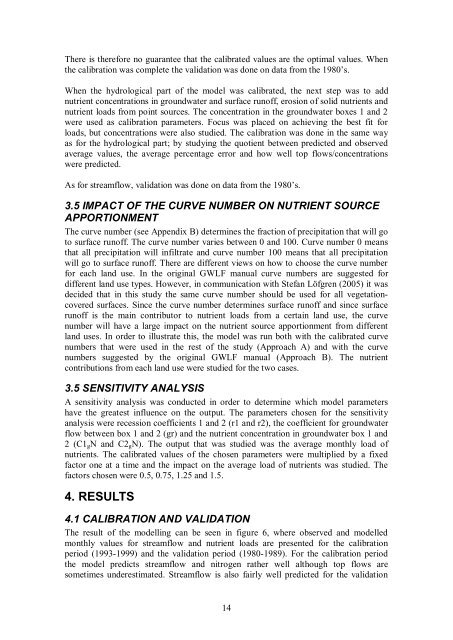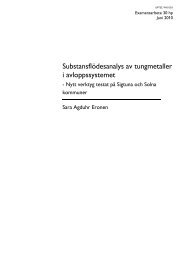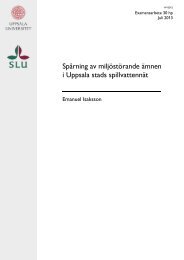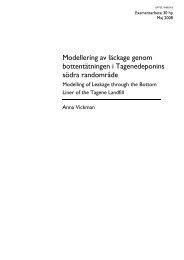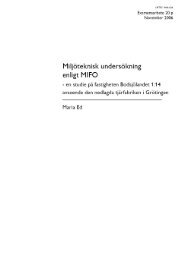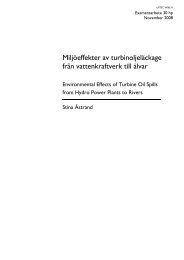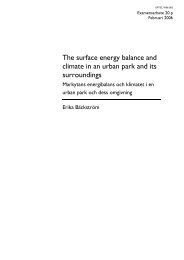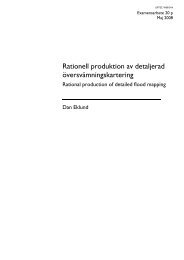Nutrient Transport Modelling in the Daugava River Basin - DiVA Portal
Nutrient Transport Modelling in the Daugava River Basin - DiVA Portal
Nutrient Transport Modelling in the Daugava River Basin - DiVA Portal
Create successful ePaper yourself
Turn your PDF publications into a flip-book with our unique Google optimized e-Paper software.
There is <strong>the</strong>refore no guarantee that <strong>the</strong> calibrated values are <strong>the</strong> optimal values. When<strong>the</strong> calibration was complete <strong>the</strong> validation was done on data from <strong>the</strong> 1980’s.When <strong>the</strong> hydrological part of <strong>the</strong> model was calibrated, <strong>the</strong> next step was to addnutrient concentrations <strong>in</strong> groundwater and surface runoff, erosion of solid nutrients andnutrient loads from po<strong>in</strong>t sources. The concentration <strong>in</strong> <strong>the</strong> groundwater boxes 1 and 2were used as calibration parameters. Focus was placed on achiev<strong>in</strong>g <strong>the</strong> best fit forloads, but concentrations were also studied. The calibration was done <strong>in</strong> <strong>the</strong> same wayas for <strong>the</strong> hydrological part; by study<strong>in</strong>g <strong>the</strong> quotient between predicted and observedaverage values, <strong>the</strong> average percentage error and how well top flows/concentrationswere predicted.As for streamflow, validation was done on data from <strong>the</strong> 1980’s.3.5 IMPACT OF THE CURVE NUMBER ON NUTRIENT SOURCEAPPORTIONMENTThe curve number (see Appendix B) determ<strong>in</strong>es <strong>the</strong> fraction of precipitation that will goto surface runoff. The curve number varies between 0 and 100. Curve number 0 meansthat all precipitation will <strong>in</strong>filtrate and curve number 100 means that all precipitationwill go to surface runoff. There are different views on how to choose <strong>the</strong> curve numberfor each land use. In <strong>the</strong> orig<strong>in</strong>al GWLF manual curve numbers are suggested fordifferent land use types. However, <strong>in</strong> communication with Stefan Löfgren (2005) it wasdecided that <strong>in</strong> this study <strong>the</strong> same curve number should be used for all vegetationcoveredsurfaces. S<strong>in</strong>ce <strong>the</strong> curve number determ<strong>in</strong>es surface runoff and s<strong>in</strong>ce surfacerunoff is <strong>the</strong> ma<strong>in</strong> contributor to nutrient loads from a certa<strong>in</strong> land use, <strong>the</strong> curvenumber will have a large impact on <strong>the</strong> nutrient source apportionment from differentland uses. In order to illustrate this, <strong>the</strong> model was run both with <strong>the</strong> calibrated curvenumbers that were used <strong>in</strong> <strong>the</strong> rest of <strong>the</strong> study (Approach A) and with <strong>the</strong> curvenumbers suggested by <strong>the</strong> orig<strong>in</strong>al GWLF manual (Approach B). The nutrientcontributions from each land use were studied for <strong>the</strong> two cases.3.5 SENSITIVITY ANALYSISA sensitivity analysis was conducted <strong>in</strong> order to determ<strong>in</strong>e which model parametershave <strong>the</strong> greatest <strong>in</strong>fluence on <strong>the</strong> output. The parameters chosen for <strong>the</strong> sensitivityanalysis were recession coefficients 1 and 2 (r1 and r2), <strong>the</strong> coefficient for groundwaterflow between box 1 and 2 (gr) and <strong>the</strong> nutrient concentration <strong>in</strong> groundwater box 1 and2 (C1 g N and C2 g N). The output that was studied was <strong>the</strong> average monthly load ofnutrients. The calibrated values of <strong>the</strong> chosen parameters were multiplied by a fixedfactor one at a time and <strong>the</strong> impact on <strong>the</strong> average load of nutrients was studied. Thefactors chosen were 0.5, 0.75, 1.25 and 1.5.4. RESULTS4.1 CALIBRATION AND VALIDATIONThe result of <strong>the</strong> modell<strong>in</strong>g can be seen <strong>in</strong> figure 6, where observed and modelledmonthly values for streamflow and nutrient loads are presented for <strong>the</strong> calibrationperiod (19931999) and <strong>the</strong> validation period (19801989). For <strong>the</strong> calibration period<strong>the</strong> model predicts streamflow and nitrogen ra<strong>the</strong>r well although top flows aresometimes underestimated. Streamflow is also fairly well predicted for <strong>the</strong> validation14


